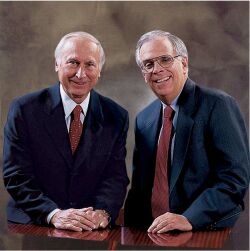|
Class-D Amplifier
A class-D amplifier, or switching amplifier, is an electronic amplifier in which the amplifying devices (transistors, usually MOSFETs) operate as electronic switches, and not as linear gain devices as in other amplifiers. They operate by rapidly switching back and forth between the supply rails, using pulse-width modulation, pulse-density modulation, or related techniques to produce a pulse train output. A simple low-pass filter may be used to attenuate their high-frequency content to provide analog output current and voltage. Little energy is dissipated in the amplifying transistors because they are always either fully on or fully off, so efficiency can exceed 90%. History The first class-D amplifier was invented by British scientist Alec Reeves in the 1950s and was first called by that name in 1955. The first commercial product was a kit module called the X-10 released by Sinclair Radionics in 1964. However, it had an output power of only 2.5 watts. The Sinclair X-20 in ... [...More Info...] [...Related Items...] OR: [Wikipedia] [Google] [Baidu] |
Integrated Circuit
An integrated circuit (IC), also known as a microchip or simply chip, is a set of electronic circuits, consisting of various electronic components (such as transistors, resistors, and capacitors) and their interconnections. These components are etched onto a small, flat piece ("chip") of semiconductor material, usually silicon. Integrated circuits are used in a wide range of electronic devices, including computers, smartphones, and televisions, to perform various functions such as processing and storing information. They have greatly impacted the field of electronics by enabling device miniaturization and enhanced functionality. Integrated circuits are orders of magnitude smaller, faster, and less expensive than those constructed of discrete components, allowing a large transistor count. The IC's mass production capability, reliability, and building-block approach to integrated circuit design have ensured the rapid adoption of standardized ICs in place of designs using discre ... [...More Info...] [...Related Items...] OR: [Wikipedia] [Google] [Baidu] |
Quantization (signal Processing)
Quantization, in mathematics and digital signal processing, is the process of mapping input values from a large set (often a continuous set) to output values in a (countable) smaller set, often with a finite number of elements. Rounding and truncation are typical examples of quantization processes. Quantization is involved to some degree in nearly all digital signal processing, as the process of representing a signal in digital form ordinarily involves rounding. Quantization also forms the core of essentially all lossy compression algorithms. The difference between an input value and its quantized value (such as round-off error) is referred to as quantization error, noise or distortion. A device or algorithm function, algorithmic function that performs quantization is called a quantizer. An analog-to-digital converter is an example of a quantizer. Example For example, Rounding#Round half up, rounding a real number x to the nearest integer value forms a very basic type of q ... [...More Info...] [...Related Items...] OR: [Wikipedia] [Google] [Baidu] |
SPDIF
S/PDIF (Sony/Philips Digital Interface) is a type of digital audio interface used in consumer audio equipment to output audio over relatively short distances. The signal is transmitted over either a coaxial cable using RCA or BNC connectors, or a fibre-optic cable using TOSLINK connectors. S/PDIF interconnects components in home theaters and other digital high-fidelity systems. S/PDIF is based on the AES3 interconnect standard. S/PDIF can carry two channels of uncompressed PCM audio or compressed 5.1 surround sound; it cannot support lossless surround formats that require greater bandwidth. S/PDIF is a data link layer protocol as well as a set of physical layer specifications for carrying digital audio signals over either optical or electrical cable. The name stands for Sony/Philips Digital Interconnect Format but is also known as Sony/Philips Digital Interface. Sony and Philips were the primary designers of S/PDIF. S/PDIF is standardized in IEC 60958 as IEC 60958 type ... [...More Info...] [...Related Items...] OR: [Wikipedia] [Google] [Baidu] |
Duty Cycle
A duty cycle or power cycle is the fraction of one period in which a signal or system is active. Duty cycle is commonly expressed as a percentage or a ratio. A period is the time it takes for a signal to complete an on-and-off cycle. As a formula, a duty cycle (%) may be expressed as: :D = \frac \times 100\% Equally, a duty cycle (ratio) may be expressed as: :D = \frac where D is the duty cycle, PW is the pulse width (pulse active time), and T is the total period of the signal. Thus, a 60% duty cycle means the signal is on 60% of the time and off 40% of the time. The "on time" for a 60% duty cycle could be a fraction of a second, a day, or even a week, depending on the length of the period. Duty cycles can be used to describe the percent time of an active signal in an electrical device such as the power switch in a switching power supply or the firing of action potentials by a living system such as a neuron. Some publications use \alpha as the symbol for duty cycle. As a ... [...More Info...] [...Related Items...] OR: [Wikipedia] [Google] [Baidu] |
Comparator
In electronics, a comparator is a device that compares two voltages or currents and outputs a digital signal indicating which is larger. It has two analog input terminals V_+ and V_- and one binary digital output V_\text. The output is ideally : V_\text = \begin 1, & \textV_+ > V_-, \\ 0, & \textV_+ < V_-. \end A comparator consists of a specialized high- gain . They are commonly used in devices that measure and digitize analog signals, such as s (ADCs), as well as [...More Info...] [...Related Items...] OR: [Wikipedia] [Google] [Baidu] |
Analog Devices
Analog Devices, Inc. (ADI), also known simply as Analog, is an American multinational corporation, multinational semiconductor company specializing in data conversion, signal processing, and power management technology, headquartered in Wilmington, Massachusetts. The company manufactures analog, Mixed-signal integrated circuit, mixed-signal and digital signal processing, digital signal processing (DSP) integrated circuits (ICs) used in electronic equipment. These technologies are used to convert, condition and process real-world phenomena, such as light, sound, temperature, motion, and pressure into electrical signals. Analog Devices has approximately 100,000 customers in the following industries: communications, computer, instrumentation, military/aerospace, automotive, and consumer electronics applications.Bloomberg.ADI: Analog Devices Inc Summary" Retrieved January 30, 2011. History The company was founded by two MIT graduates, Ray Stata and Matthew Lorber in 1965. The same ... [...More Info...] [...Related Items...] OR: [Wikipedia] [Google] [Baidu] |
Delta-sigma Modulation
Delta-sigma (ΔΣ; or sigma-delta, ΣΔ) modulation is an oversampling method for encoding signals into low bit depth digital signals at a very high sample-frequency as part of the process of delta-sigma analog-to-digital converters (ADCs) and digital-to-analog converters (DACs). Delta-sigma modulation achieves high quality by utilizing a negative feedback loop during quantization to the lower bit depth that continuously corrects quantization errors and moves quantization noise to higher frequencies well above the original signal's bandwidth. Subsequent low-pass filtering for demodulation easily removes this high frequency noise and time averages to achieve high accuracy in amplitude, which can be ultimately encoded as pulse-code modulation (PCM). Both ADCs and DACs can employ delta-sigma modulation. A delta-sigma ADC (e.g. Figure 1 top) encodes an analog signal using high-frequency delta-sigma modulation and then applies a digital filter to demodulate it t ... [...More Info...] [...Related Items...] OR: [Wikipedia] [Google] [Baidu] |
Sliding Mode Control
In control systems, sliding mode control (SMC) is a nonlinear control method that alters the dynamic system, dynamics of a nonlinear system by applying a discontinuous control signal (or more rigorously, a set-valued control signal) that forces the system to "slide" along a cross-section of the system's normal behavior. The state space (controls), state-feedback control law is not a continuous function of time. Instead, it can switch from one continuous structure to another based on the current position in the state space. Hence, sliding mode control is a variable structure control method. The multiple control structures are designed so that trajectories always move toward an adjacent region with a different control structure, and so the ultimate trajectory will not exist entirely within one control structure. Instead, it will ''slide'' along the boundaries of the control structures. The motion of the system as it slides along these boundaries is called a ''sliding mode'' and the g ... [...More Info...] [...Related Items...] OR: [Wikipedia] [Google] [Baidu] |
Class-A Amplifier
In electronics, power amplifier classes are letter symbols applied to different Amplifier#Power_amplifiers, power amplifier types. The class gives a broad indication of an amplifier's Electrical efficiency, efficiency, linearity and other characteristics. Broadly, as you go up the alphabet, the amplifiers become more efficient but less linear, and the reduced linearity is dealt with through other means. The first classes, A, AB, B, and C, are related to the time period that the active amplifier device is passing current, expressed as a fraction of the period of a signal waveform applied to the input. This metric is known as conduction angle (\theta). A class-A amplifier is conducting through the entire period of the signal (\theta=360°); class-B only for one-half the input period (\theta=180°), class-C for much less than half the input period (\theta 180°); each one of the two active elements conducts more than half of the time. Class-AB is widely considered a good compromise f ... [...More Info...] [...Related Items...] OR: [Wikipedia] [Google] [Baidu] |
Class AB
In electronics, power amplifier classes are letter symbols applied to different power amplifier types. The class gives a broad indication of an amplifier's efficiency, linearity and other characteristics. Broadly, as you go up the alphabet, the amplifiers become more efficient but less linear, and the reduced linearity is dealt with through other means. The first classes, A, AB, B, and C, are related to the time period that the active amplifier device is passing current, expressed as a fraction of the period of a signal waveform applied to the input. This metric is known as conduction angle (\theta). A class-A amplifier is conducting through the entire period of the signal (\theta=360°); class-B only for one-half the input period (\theta=180°), class-C for much less than half the input period (\theta 180°); each one of the two active elements conducts more than half of the time. Class-AB is widely considered a good compromise for amplifiers, since many types of input signal are ... [...More Info...] [...Related Items...] OR: [Wikipedia] [Google] [Baidu] |




